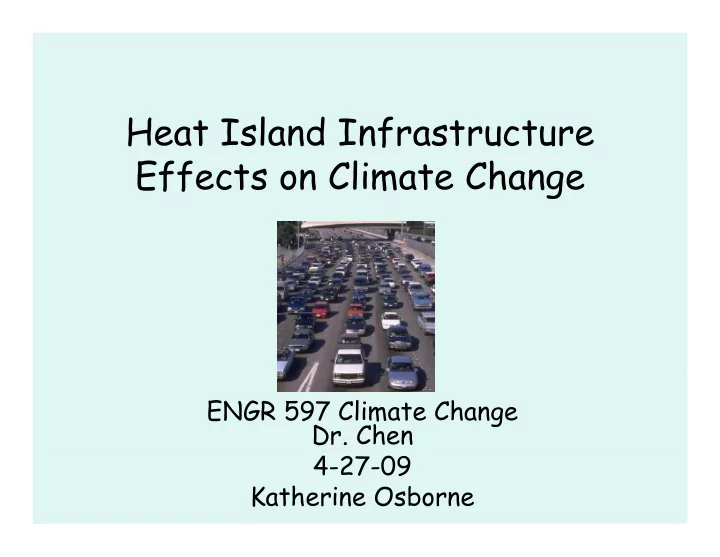

Heat Island Infrastructure Effects on Climate Change Effects on Climate Change ENGR 597 Climate Change Dr. Chen 4-27-09 Katherine Osborne
Heat Island Effects • Urban Areas are particularly susceptible to the planet’s rising temperatures • Concrete and Asphalt –main contributors Concrete and Asphalt main contributors • The annual mean air temperature of a city with 1 million people or more can be 1.8–5.4°F (1–3°C) warmer than its surroundings. • In the evening, the difference can be as high as 22°F (12°C). In the even ng, the d fference can be as h gh as F ( C). • Heat islands can affect communities by increasing summertime peak energy demand, air conditioning costs, air pollution and greenhouse gas emissions, heat-related illness and mortality, and water quality. Source :http://www.epa.gov/hiri/
Measuring Heat Island Temperature • Urban surfaces can be anywhere from 27-50 º C (50-90 F). • Shaded and moist areas remain close to air temperatures.
Hwy 6 Figure 1. The IKONOS imagery of the intersection (courtesy of Space Imaging) Surface Surface Surface Surface IMAGES Ground- IMAGES Ground- IMAGES Ground- IMAGES Ground- Class Class Class Class Results Results Results Results Truth Truth Truth Truth Asphalt Asphalt Asphalt Asphalt 21.8% 21.8% 21.8% 21.8% 22.9% 22.9% 22.9% 22.9% Concrete Concrete Concrete Concrete 1.0% 1.0% 1.0% 1.0% 0.6% 0.6% 0.6% 0.6% Grass Grass Grass Grass 32.4% 32.4% 32.4% 32.4% 32.3% 32.3% 32.3% 32.3% Tree Tree Tree Tree 27.5% 27.5% 27.5% 27.5% % % % % 22.2% 22.2% 22.2% 22.2% % % % % Soil Soil Soil Soil 13.3% 13.3% 13.3% 13.3% 22.0% 22.0% 22.0% 22.0% Building/ Building/ Building/ Building/ 3.8% 3.8% 3.8% 3.8% Built-up Built-up Built-up Built-up Areas Areas Areas Areas Stream/ Stream/ Stream/ Stream/ 0.0% 0.0% 0.0% 0.0% 0.0% 0.0% 0.0% 0.0% Watershed Watershed Watershed Watershed Watershed Watershed Watershed Watershed Unknown Unknown Unknown Unknown 0.2% 0.2% 0.2% 0.2% 0.0% 0.0% 0.0% 0.0% 100.0% 100.0% 100.0% 100.0% 100.0% 100.0% 100.0% 100.0% Figure 2. The automatically classified map of the intersection area (by CAIT’s program)
Surface Temperature Profile Surface Temperature Profile • Surface class data are used to predict surface t temperature using climatological data for the study t i li t l i l d t f th t d area • Hottest hour in Oxford in 2001 • 8km x 8km study area along the N-S and E-W cross sections • Profile predicted from a series of predicted surface p p temperature on continuous sub areas i b • 60% trees, avg. surface temp high –solar radiation, wind speed was low • Average surface temp in the built-up area within the city has an average 9 º C higher than ambient air temp.
Solutions Solutions • Increase tree and Increase tree and vegetation cover • Creating green- Creating green roofs • Cool-roofs f (reflective) • Use cool pavements
Cool Pavements Cool Pavements • Researchers at LBNL have estimated that Researchers at LBNL have estimated that every 10 percent increase in solar reflectance could decrease surface temperatures by 7ºF (4ºC). • Further, they predicted that if pavement y p p reflectance throughout a city were increased from 10 percent to 35 percent, th the air temperature could potentially be i t t ld t ti ll b reduced by 1ºF (0.6ºC). http://www.epa.gov/hiri/resources/pdf/CoolPavesCompendium.pdf
Grass Pavements Grass Pavements This 300,000-square-foot (28,000 m2) parking lot outside a stadium in Houston uses plastic grid pavers that allow grass to grow in the open spaces.
Grass Pavements Grass Pavements • It performs the functions of asphalt or concrete pavement, but with the aesthetics of a lawn – all while t b t ith th th ti f l ll hil enhancing the environment. • High void spaces within the entire cross-section enable excellent root development, and storage bl ll t t d l t d t capacity for rainfall from storm events. • Benefits: • P Pervious Load Bearing Surface i L d B i S f • Stormwater Pollution Filtration and Treatment • Airborne Dust Capture and Retention p • Heat Energy Reflection Reduction, “Cool” Surface • Tree Growth within Parking Areas
Oxford MS Oxford, MS Imagery taken on March 27, 800-m 2000 2000. 1,200-m
Oxford, MS with Completed L Landuse Areas Extraction d A E i 800-m 1,200-m
Weighted Average Surface Temperature Prediction for the T t P di ti f th 800x120 sq m study area during q y g the hottest hour in Oxford, 2001 Percent Predicted Surface temp Surface Class Area Area Temp distribution asphalt parking 30,925 0.03 64.9 2.091 built area 50,592 0.05 64.9 3.420 tree 339,723 0.35 45.3 16.031 grass 376,944 0.39 46.8 18.376 pavement 41,155 0.04 64.9 2.782 soil 120,660 0.13 54.1 6.800 total 960,000.00 49.500 Note: air temp 34.8 deg C July 11, 2001 3-4 pm, hottest hour
Weighted Average Surface T Temperature Prediction when t P di ti h replacing all asphalt parking areas p g p p g with grass Percent Predicted Surface temp Surface Class Area Area Temp distribution asphalt parking ki 0 0 0 00 0.00 64 9 64.9 0.000 0 000 built area 50,592 0.05 64.9 3.420 tree 339,723 0.35 45.3 16.031 grass 407,869 0.42 46.8 19.884 pavement t 41,155 41 155 0 04 0.04 64 9 64.9 2 782 2.782 soil 120,660 0.13 54.1 6.800 total 960,000.00 48.916
Conclusions Conclusions • Constructed surface temp hi h higher than natural surfaces th t l f • CAIT research shows about a 3º increase due to the effects of constructed effects of constructed surfaces • Electricity demand for cooling increases 1.5-2.0% g for every 0.6ºC, increase in air temperature, 5-10% electricity in used to compensate for the heat compensate for the heat island effect
Benefits for Reducing the Heat I l Island Effect d Eff • Reduce energy R d consumption • Reduce air pollutants • Reduce air pollutants and greenhouse gases gases • Improved human health and comfort h a th an comfort • Improved Water Quality Q y
Recommend
More recommend